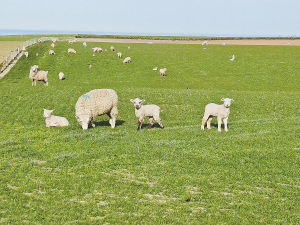Woollen covers that keep newborn lambs safe, warm
A Christchurch manufacturer of woollen covers for newborn lambs says his covers pay dividends in survival rates and liveweight gains, especially at a time when farmers are feeling the economic pinch.
 The ideal weaning date should be guided by maximising feed supplied to lambs and protecting ewe condition.
The ideal weaning date should be guided by maximising feed supplied to lambs and protecting ewe condition.
The ideal weaning date should be guided by whether it achieves two key goals.
Firstly, maximising profit from feed supplied to lambs and ewes and, secondly, protecting ewe condition so she is productive the following year.
Ewe intake increases two to three weeks into lactation and builds to a peak at eight weeks. However, milk production peaks at between two and four weeks. The ewe simply can't eat enough to meet her lactation and energy requirements. At peak lactation, single ewes consume around 2.5kg DM/day (dry matter per day) and twinning ewes 3kg DM/day.
In late lactation, well-fed ewes (especially with a single lamb) can gain weight. Lactating ewes use feed 20% more efficiently to put on LW than dry ewes. But they have 10% higher maintenance requirements which is a cost.
Four weeks after lambing, a ewe's milk production peaks then starts to drop steadily by 19 to 26 g/day (grams/day).
Good nutrition is needed to achieve high peak milk production. However, nutrition levels don't really affect the subsequent milk decline rate.
Some breeds produce a higher volume of milk, for example East Friesian. It is estimated that the lamb weight difference between high and low milking ewes is 3kg of weaning weight.
Having high-milking breeds doesn't really benefit a single lamb as they can't consume all the milk produced. Research compared high milking Poll Dorsets to Romneys, with the Poll Dorset having a live weight gain advantage of 13 g/day in single lambs and a 30 g/day advantage in twins.
Suckling duration and frequency alters milk production.
Extra suckling from twins stimulates the ewe to produce approximately 35% more milk in early lactation and 18% more in late lactation.
Research showed that a pre-weaning intake of 2.07kg DM/ewe can drop to a maintenance feeding level of 0.92kg after weaning. Stopping lactation frees up energy for the ewe herself.
Usually, ewe liveweight gain increases by 50 g/head/day after weaning, if fed at the same level.
To get ewes to grow at 100g/day, feed worth over 10MJME/kg DM (megajoules of metabolisable energy) is needed. An example would be lucerne or summer brassica. This can be hard to provide (and therefore expensive) in summer. If weaning is delayed and ewes lose weight when feed is tight, it can be costly to make up ewe weight.
Each kg of ewe liveweight lost is equal to 17MJME but it takes 65MJME to put one kg of weight back on. For this reason, on summer-dry farms ewes should be weaned at her target mating weight for the following year e.g. 65kg. Ewes weaned at the target weight don't have to gain weight over summer.
They can be used to clean up aged or dried grass, helping condition pastures.
The lamb's rumen is fully capable of digesting pasture by three weeks of age. Lambs weaned before six weeks are likely to suffer, as they can't make up for the lost milk by suddenly increasing pasture intake. Feed intake levels are too low.
Lambs can increase pasture intake a little if milk intake declines but a lamb under 8 weeks is likely to grow better on its mother than if weaned. A crossbred lamb born at 4.5kg and gaining 250g/day will weigh only 18.5kg liveweight at 8 weeks.
Research shows lamb growth peaks somewhere between day 20 and 40 of lactation (at an average of 250-350g/ head/day). Lambs can partially compensate for lower milk availability by consuming more pasture. Lamb growth can stay high in late lactation if pasture quality is over 10.5 MJME/kg DM e.g. leafy green grass, legumes, brassicas.
Single lambs consume more milk and grow around 80g/day faster than twin lambs in early lactation and 35g/day faster than twins in late lactation.
This occurs even if twin ewes are grazing high pasture covers. Although ewes produce more milk for twins, these lambs get around 68% and 59% of the milk intake of single lambs in peak and late lactation respectively.
Triplet lambs get even less milk as the ewe can't physically respond any more to the suckling stimulus.
Half the difference in lamb weaning weight between lines of sheep can be attributed to the genetic makeup of the lamb. Heavier breed animals typically consume more feed and grow more efficiently.
If ewes and lambs are well fed with pasture and ewes are milking well, then weaning between 8 to 12 weeks will reduce lamb growth. Research shows that lighter lambs often have less of a 'check' than heavier lambs are weaning. It may be better not to wean lambs (especially single lambs) within 2-3 kg of sale weight as weaning will delay sale date.
Summary
Source: https://beeflambnz.com/
The National Wild Goat Hunting Competition has removed 33,418 wild goats over the past three years.
New Zealand needs a new healthcare model to address rising rates of obesity in rural communities, with the current system leaving many patients unable to access effective treatment or long-term support, warn GPs.
Southland farmers are being urged to put safety first, following a spike in tip offs about risky handling of wind-damaged trees
Third-generation Ashburton dairy farmers TJ and Mark Stewart are no strangers to adapting and evolving.
When American retail giant Cosco came to audit Open Country Dairy’s new butter plant at the Waharoa site and give the green light to supply their American stores, they allowed themselves a week for the exercise.
Fonterra chair Peter McBride says the divestment of Mainland Group is their last significant asset sale and signals the end of structural changes.